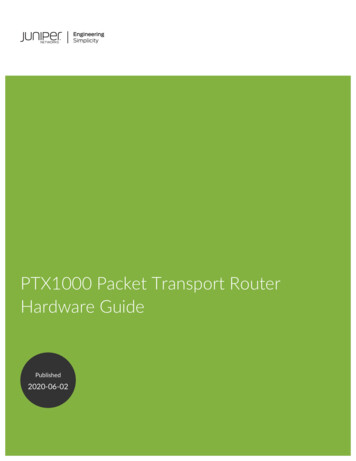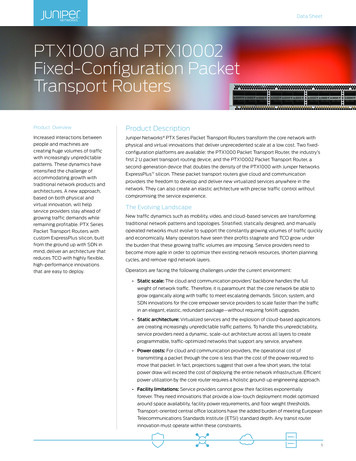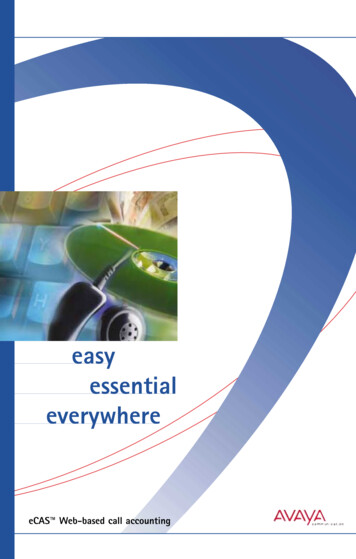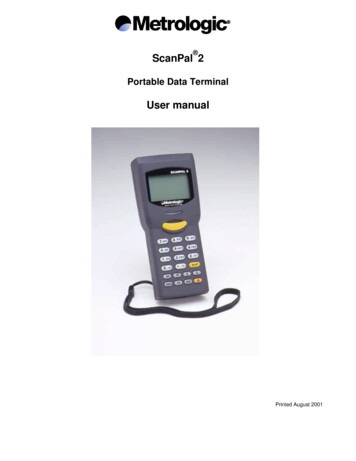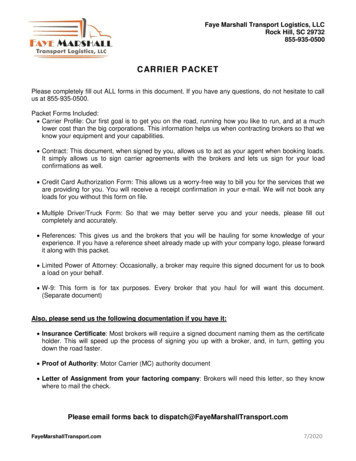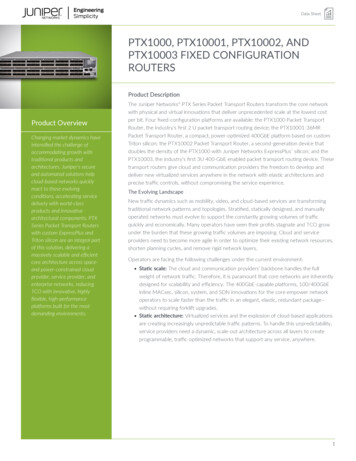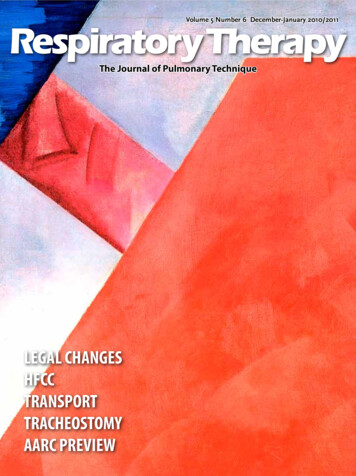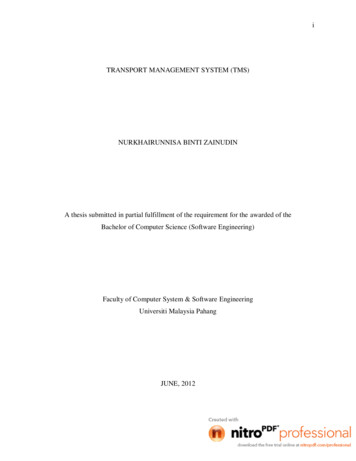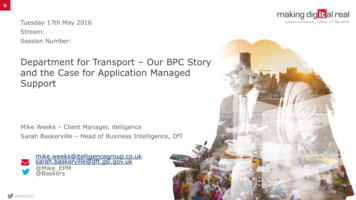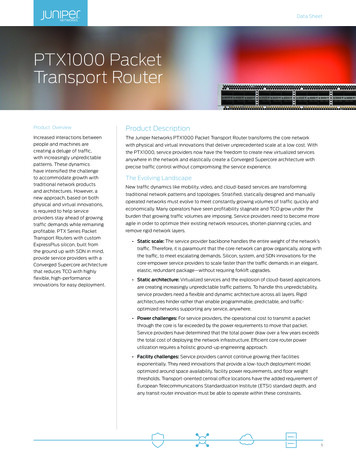
Transcription
Data SheetPTX1000 PacketTransport RouterProduct OverviewProduct DescriptionIncreased interactions betweenThe Juniper Networks PTX1000 Packet Transport Router transforms the core networkpeople and machines arewith physical and virtual innovations that deliver unprecedented scale at a low cost. Withcreating a deluge of traffic,the PTX1000, service providers now have the freedom to create new virtualized serviceswith increasingly unpredictableanywhere in the network and elastically create a Converged Supercore architecture withpatterns. These dynamicshave intensified the challengeto accommodate growth withtraditional network productsand architectures. However, anew approach, based on bothphysical and virtual innovations,is required to help serviceprecise traffic control without compromising the service experience.The Evolving LandscapeNew traffic dynamics like mobility, video, and cloud-based services are transformingtraditional network patterns and topologies. Stratified, statically designed and manuallyoperated networks must evolve to meet constantly growing volumes of traffic quickly andeconomically. Many operators have seen profitability stagnate and TCO grow under theproviders stay ahead of growingburden that growing traffic volumes are imposing. Service providers need to become moretraffic demands while remainingagile in order to optimize their existing network resources, shorten planning cycles, andprofitable. PTX Series Packetremove rigid network layers.Transport Routers with customExpressPlus silicon, built fromthe ground up with SDN in mind,provide service providers with a Static scale: The service provider backbone handles the entire weight of the network’straffic. Therefore, it is paramount that the core network can grow organically, along withthe traffic, to meet escalating demands. Silicon, system, and SDN innovations for theConverged Supercore architecturecore empower service providers to scale faster than the traffic demands in an elegant,that reduces TCO with highlyelastic, redundant package—without requiring forklift upgrades.flexible, high-performanceinnovations for easy deployment. Static architecture: Virtualized services and the explosion of cloud-based applicationsare creating increasingly unpredictable traffic patterns. To handle this unpredictability,service providers need a flexible and dynamic architecture across all layers. Rigidarchitectures hinder rather than enable programmable, predictable, and trafficoptimized networks supporting any service, anywhere. Power challenges: For service providers, the operational cost to transmit a packetthrough the core is far exceeded by the power requirements to move that packet.Service providers have determined that the total power draw over a few years exceedsthe total cost of deploying the network infrastructure. Efficient core router powerutilization requires a holistic ground-up engineering approach. Facility challenges: Service providers cannot continue growing their facilitiesexponentially. They need innovations that provide a low-touch deployment modeloptimized around space availability, facility power requirements, and floor weightthresholds. Transport-oriented central office locations have the added requirement ofEuropean Telecommunications Standardization Institute (ETSI) standard depth, andany transit router innovation must be able to operate within these constraints.1
PTX1000 Packet Transport RouterData SheetIn order to address these challenges, service providers need anproviders when peering. The PTX1000 expands the applicationsinnovative core router that delivers three defining principles:scope that the Converged Supercore architecture addresses,performance, deployability, and SDN programmability. Withenabling service providers to implement a distributed coreJuniper Networks PTX1000 Packet Transport Router, Juniperarchitecture for interconnecting growing cloud services. Serviceintroduces the industry’s only fixed core router that exceedsproviders can distribute peering points to match traffic demandthese requirements and easily fits into the service providerwith an optimized core router without sacrificing performance ornetwork, expanding the Juniper Networks Converged Supercore deployability. The PTX1000 is the industry’s only fix configurationarchitecture beyond lean label-switching router (LSR)core router in a compact, 2 U form factor, making it easilydeployments.deployable in space-constrained Internet exchange locations,remote central offices, and embedded peering points anywherePTX Seriesin the network, including cloud-hosted services.The Juniper Networks PTX Series Packet Transport Routers bringThe PTX1000 operates at 2.88 Tbps in a fixed core routerphysical and virtual innovations to the service provider coreconfiguration and supports flexible interface configurationnetwork. These directly address concerns about operationaloptions, including 288 x 10GbE ports via a quad small form-expenditures while scaling organically to keep pace withgrowing traffic demands. In order for PTX Series routers to lowerports via QSFP , and 24 x 100GbE ports via QSFP28. Like theoperational expenses, physical innovations at the core siliconare needed. PTX Series routers are powered by Juniper NetworksExpressPlus silicon, building upon the Juniper Networks Junos factor pluggable plus transceiver (QSFP ) breakout, 72 x 40GbE Express silicon concepts of low consistent latency and wirerate packet performance for both IP traffic and MPLS transportwithout sacrificing the optimized system power profile. All ofthese concepts are incorporated into the design along withfull IP functionality, preserving the spirit of the original JunosExpress chipset. The ExpressPlus silicon is the first purpose-builttelecommunication silicon to engineer a 3D memory architectureinto the base design for more than 1.6 billion filter operationsper second, dynamic table memory allocation for mammoth IProuting scale, and enormous power efficiency gains.rest of the PTX Series, the PTX1000 is powered by ExpressPlussilicon, offering predictable IP/MPLS packet performance andfunctionality. ExpressPlus silicon also eliminates the complexsawtooth packet profile found in elaborate over-engineerednetwork processing units (NPUs) deployed in other corerouters. This delivers the distributed peering scale (2 millionplus forwarding information base [FIB] and 5 million routinginformation base [RIB], also known as forwarding and routingtables, respectively), required to match expanding traffic demands.Features and BenefitsPerformance is one of the guiding design principles for the PTXSeries routers. This focus empowers service providers withThe ability to address service provider core networkingsuperior scale to match increased traffic demands and networkrequirements of performance, deployability, and SDN controlengineering challenges with predictable system latency tobegins with the silicon. The integration of optical transport withimprove the overall service experience, deliver best-in-class100GbE coherent technology further improves the economicsresiliency, and ensure that service providers meet strict customerof the core network. With PTX Series routers powered byservice-level agreements (SLAs).the ExpressPlus silicon, service providers can now deploy aConverged Supercore architecture with the efficiency of a leancore deployment featuring Juniper Networks NorthStar Controller,a robust, full-featured Internet backbone router, and a convergedregional IP/MPLS core router with integrated 100GbE coherentDeployability is the other guiding design principle for thePTX Series routers, focusing on power, space, and weight—fundamental concerns that impact service providers’ operationalbudget with respect to growing traffic demands.transport for superior performance, elegant deployment, andSDN programmability brings virtual innovations to the serviceSDN programmability.provider core, while the NorthStar Controller is an open,PTX1000For the first time, the PTX1000 lets service providers organicallydistribute peering points throughout the network with a richIP/MPLS feature set without sacrificing performance andstandards-based solution that optimizes both the IP layer andthe transport layer with precise SDN control, allowing serviceproviders to automate and scale operations.Table 1 summarizes the features available on the PTX1000 router.deployability—the main contributors to eroding TCO for service2
PTX1000 Packet Transport RouterData SheetTable 1: PTX1000 Features and BenefitsFeatureFeature DescriptionBenefitSystem capacityThe PTX1000 scales to 2.88 Tbps in a single chassis,breaking out into 288 10GbE, 72 40GbE, and 24100GbE interfaces.PTX1000 routers give service providers theperformance and scalability needed to outpaceincreased traffic demands.High availability hardwareThe PTX1000 is engineered with hardwareredundancy for cooling, power supply, andforwarding.High availability (HA) is a critical requirementfor service providers to maintain an always oninfrastructure base for meeting stringent SLAsacross the core.High availability softwareThe PTX1000 features a resilient operating systemthat supports HA features such as graceful RoutingEngine switchover (GRES), nonstop active routing(NSR), and unified in-service software upgrade(unified ISSU) for high availability.Juniper Networks Junos operating system supportsHA features that allow software upgrades andchanges without disrupting network traffic.Packet performanceGroundbreaking ExpressPlus silicon empowersthe PTX1000 with unparalleled packet processingfor both full IP functionality and MPLS transport,thereby leveraging revolutionary 3D memoryarchitecture.Exceptional packet processing capabilities helpalleviate the challenge of scaling the network astraffic levels increase while optimizing IP/MPLStransit functionality around superior performanceand elegant deployability.Ultra-compact 2 U form factorWith cutting-edge innovation in power and coolingtechnology, the PTX1000 is the only fixedconfiguration core router that provides 2.88 Tbps ofcapacity at a 2 U form factor.Space efficiency is a critical requirement for peeringInternet Exchange points, peering colocations,central offices, and regional networks, especially inemerging markets.PTX1000 Packet Transport RouterPTX1000 SpecificationsHardwareSystem throughput Up to 2.88 TbpsForwarding capacity Up to 2 BppsMaximum 10GbE port density 288Maximum 40GbE port density 72Maximum 100GbE port density 24Dimensions (W x H x D): 17.4 x 3.46 x 31 in (44.2 x 8.8 x 78.7 cm)Rack units (U) 2Weight 68.6 lb (31 kg)Operating system Junos OSCPU Intel Quad Core Ivy Bridge 2.5 GHz CPU, 16 GB SDRAMManagement and Precision Time Protocol (PTP) interfaces 1 small form-factor pluggable transceiver (SFP/SFP ) portor PTP Grandmaster Fiber (SFP) or 10/100/1000BASE-T (RJ-45) Ethernetmanagement port SMB in, SMB out, 10 MHz in, 10 MHz out One console port USB 2.0 storage interfacePower 4x 1,600 Watt AC/DC power supplyCooling Front-to-back airflow Three hot-swappable fan modules with redundant fansTotal packet buffer 24 GBLatency As low as 2.5 microseconds within a Packet ForwardingEngine (PFE) As low as 5.5 microseconds across PFEs3
PTX1000 Packet Transport RouterEnvironmental RangesData SheetEnvironmental Compliance Operating temperature: 32 to 104 F (0 to 40 C)Restriction of Hazardous Substances (ROHS) 6/6 Storage temperature: -40 to 158 F (-40 to 70 C) Operating altitude: Up to 10,000 ft. (3,048 m)Silver PSU Efficiency Relative humidity operating: 5 to 90% (noncondensing) Relative humidity nonoperating: 5 to 95% (noncondensing)Recycled material Seismic: Designed to meet GR-63, Zone 4 earthquakerequirementsWaste Electronics and Electrical Equipment (WEEE)Maximum Thermal Output* Maximum power draw: 1,425 W (AC, DC), 4,862 BTU/hrRegistration, Evaluation, Authorisation andRestriction of Chemicals (REACH) Typical power draw: 1,050 W (AC, DC), 3,583 BTU/hrChina Restriction of Hazardous Substances (ROHS)Safety and ComplianceSafety CAN/CSA-C22.2 No. 60950-1 Information TechnologyEquipment—Safety UL 60950-1 Information Technology Equipment—Safety EN 60950-1 Information Technology Equipment—SafetyTelco Common Language Equipment Identifier (CLEI) codeJuniper Networks Services and SupportJuniper Networks is the leader in performance-enabling servicesthat are designed to accelerate, extend, and optimize your IEC 60950-1 Information Technology Equipment—Safety (Allcountry deviations)high-performance network. Our services allow you to maximize EN 60825-1 Safety of Laser Products—Part 1: EquipmentClassificationrisk, achieving a faster time to value for your network. JuniperElectromagnetic Compatibilityoperational efficiency while reducing costs and minimizingNetworks ensures operational excellence by optimizing thenetwork to maintain required levels of performance, reliability, 47CFR Part 15, (FCC) Class Aand availability. For more details, please visit www.juniper.net/us/ ICES-003 Class Aen/products-services. EN 55022 Class A CISPR 22 Class A EN 55024 CISPR 24 EN 300 386Automated Support and PreventionJuniper’s Automated Support and Prevention consists of anecosystem of tools, applications, and systems targeted towardssimplifying and streamlining operations, delivering operationalefficiency, reducing downtime, and increasing your network’s ROI VCCI Class Arunning Juniper Networks Junos operating system. Automated AS/NZA CISPR22 Class ASupport and Prevention brings operational efficiency by KN22 Class Aautomating several time-consuming tasks such as incident CNS 13438 Class Amanagement, inventory management, proactive bug notification EN 61000-3-2 EN 61000-3-3 ETSIand on-demand EOL/EOS/EOE reports. The Junos Space ServiceNow and Service Insight service automation tools are standardentitlements of all Juniper Care contracts. ETSI EN 300 019: Environmental Conditions & EnvironmentalTests for Telecommunications EquipmentWarranty ETSI EN 300 019-2-1 (2000)—Storagewarranty/.For warranty information, please visit www.juniper.net/support/ ETSI EN 300 019-2-2 (1999)—Transportation ETSI EN 300 019-2-3 (2003)—Stationary Use at Weatherprotected Locations ETSI EN 300 019-2-4 (2003)—Stationary Use at NonWeather-protected Locations ETS 300753 (1997)—Acoustic noise emitted bytelecommunications equipment*Estimated; subject to change4
PTX1000 Packet Transport RouterData SheetAbout Juniper NetworksJuniper Networks is in the business of network innovation. Fromdevices to data centers, from consumers to cloud providers,Juniper Networks delivers the software, silicon and systems thattransform the experience and economics of networking. Thecompany serves customers and partners worldwide. Additionalinformation can be found at www.juniper.net.Corporate and Sales HeadquartersAPAC and EMEA HeadquartersJuniper Networks, Inc.Juniper Networks International B.V.1133 Innovation WayBoeing Avenue 240Sunnyvale, CA 94089 USA1119 PZ Schiphol-RijkPhone: 888.JUNIPER (888.586.4737)Amsterdam, The Netherlandsor 1.408.745.2000Phone: 31.0.207.125.700Fax: 1.408.745.2100Fax: 31.0.207.125.701www.juniper.netCopyright 2017 Juniper Networks, Inc. All rights reserved. Juniper Networks, the Juniper Networks logo, Juniper,and Junos are registered trademarks of Juniper Networks, Inc. in the United States and other countries. Allother trademarks, service marks, registered marks, or registered service marks are the property of theirrespective owners. Juniper Networks assumes no responsibility for any inaccuracies in this document. JuniperNetworks reserves the right to change, modify, transfer, or otherwise revise this publication without notice.1000538-005-EN May 2017EXPLORE JUNIPERGet the App.
The Juniper Networks PTX1000 Packet Transport Router transforms the core network with physical and virtual innovations that deliver unprecedented scale at a low cost. With the PTX1000, service providers now have the freedom to create new virtualized services anywhere in the network and e
